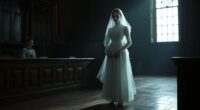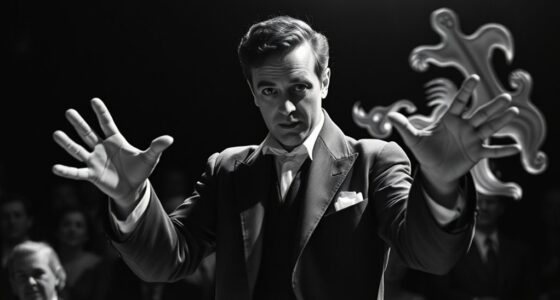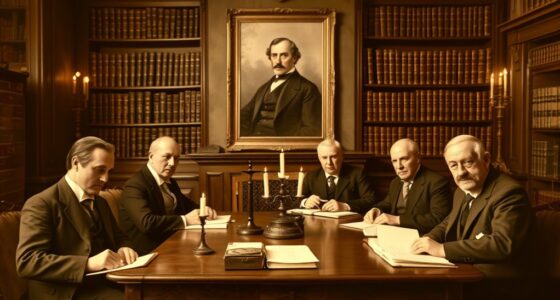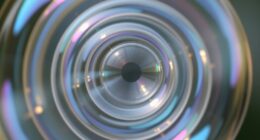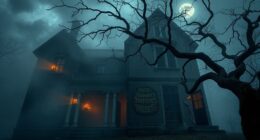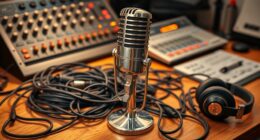In 1936, the famous Brown Lady photo was captured at Raynham Hall, showing a translucent figure descending a staircase. This iconic image sparks curiosity about ghostly encounters and paranormal phenomena. Photographers used long exposures and dim lighting to create a haunting effect, but skeptics have challenged its authenticity, suggesting tricks or editing. If you want to uncover the mysteries behind this legendary image and explore its cultural impact, there’s more to discover below.
Key Takeaways
- The Brown Lady photo was taken in 1936 at Raynham Hall using long exposure techniques to capture ghostly figures.
- The image depicts a translucent, spectral woman descending a staircase, symbolizing paranormal phenomena.
- Skeptics suggest the photo was staged with double exposures or photographic manipulations.
- Modern analysis techniques, including digital forensics, have been used to evaluate its authenticity.
- The photograph remains an iconic symbol in ghost lore, inspiring cultural media and paranormal investigations.
The Origins of the Raynham Hall Photograph

The origins of the Raynham Hall photograph trace back to 1936, when photographer Captain Hugh Crichton-Browne captured an eerie image that would become one of the most famous ghost photos ever taken. This image sparked widespread interest in paranormal investigations and fueled ghost storytelling around the world. You might wonder how such a haunting photo was possible—was it a trick, or genuine evidence of the supernatural? The picture shows a translucent figure descending a staircase, enthralling viewers and skeptics alike. Its mysterious nature has led many to analyze every detail, hoping to uncover the truth behind the apparition. This photograph’s history continues to intrigue, making it an enduring symbol in ghost lore and a pivotal piece in discussions of paranormal phenomena.
Details of the Fateful Day in 1936

On that mysterious day in 1936, you can imagine the tense atmosphere at Raynham Hall. The setup for capturing the photograph was carefully arranged, but strange things still occurred. Let’s explore what made that day so unforgettable. The event has since become one of the most famous ghost photographs, captivating many with its mysterious apparition and enduring intrigue. The environment, including the dim lighting and quiet corridors, may have contributed to the overall haunting atmosphere, enhancing the likelihood of supernatural phenomena being captured on film. Interestingly, the power of subconscious perception and the influence of ambient conditions could have played a role in the eerie outcome of that day. Additionally, the psychological factors such as expectation and perception might have influenced how witnesses interpreted the scene, further fueling the legend. Moreover, advances in AI in Business, such as image analysis and pattern recognition, could be employed today to better understand or authenticate such paranormal images.
The Haunted Raynham Hall
As the story goes, a team of photographers ventured into Raynham Hall in 1936, hoping to capture images of its rumored hauntings. The hall’s reputation for spectral activity fueled their curiosity, and they believed a photograph could prove the ghost’s existence. Some spectral theories suggest the Brown Lady’s apparition is a residual energy, while others see it as a genuine spirit. Photography ethics come into play here—was it right to manipulate or stage images to enhance the haunting? The team’s intent was to document, but doubts lingered about whether the photo truly captured a ghost or was a clever trick. Additionally, advances in camera technology around that era influenced the clarity and authenticity of such paranormal images. The debate over photo authenticity continues to spark discussions among skeptics and believers alike. The spectral image has become one of the most iconic and analyzed photographs in paranormal history. Regardless, the haunting aura of Raynham Hall made it a magnet for paranormal investigators, forever linking the location to one of history’s most famous ghost photos.
The Photographic Setup
Photographers entering Raynham Hall in 1936 prepared meticulously for their séance with the supernatural. They focused on precise camera techniques and a carefully planned lighting setup to capture the elusive Brown Lady. First, they used long exposure times to allow enough light and reveal ghostly figures. Second, their lighting was minimal, relying on natural or dim artificial light to create shadows and enhance the spectral effect. Third, they positioned the camera strategically, often with a tripod, to prevent motion blur and ensure sharpness. These choices aimed to maximize the eerie atmosphere, making sure every detail was aligned with their supernatural pursuit. Additionally, the use of natural light and careful framing contributed significantly to the photograph’s haunting quality. To further enhance the spectral appearance, they also employed specific camera techniques that accentuated the ghostly features and minimized distractions in the scene. Moreover, their understanding of exposure settings allowed them to manipulate image clarity and ghostly transparency effectively. Furthermore, their knowledge of sound healing science could have helped them maintain a focused and calm mindset during the shoot, potentially influencing their ability to capture the supernatural image. They may have also used psychological techniques to foster a receptive mental state, aiding in the perception of supernatural phenomena.
Analyzing the Image: What Makes It So Compelling?

The ghostly figure in the photo captures your attention immediately due to its eerie clarity and ambiguous form. Its presence sparks curiosity because of the way it seems to embody paranormal symbolism—an ethereal silhouette hinting at a spiritual presence. You notice that the figure’s semi-transparent nature could be influenced by photographic artifacts, such as light reflections or film flaws, which often contribute to ghost images. Still, the image’s composition, with the figure seemingly emerging from the darkness, amplifies its haunting effect. The contrast between the shadowy background and the luminous apparition adds to the mystique, making it compelling. This blend of eerie ambiguity and technical imperfections causes your mind to ponder whether it’s a true paranormal manifestation or a clever manipulation of photographic artifacts.
Theories and Explanations Behind the Apparition

Many skeptics believe that the ghostly apparition in the 1936 photo results from photographic artifacts rather than a supernatural presence. They argue that the image’s strange shape can be explained by technical flaws or camera issues. When exploring paranormal theories, some suggest the figure is an actual spirit captured unexpectedly. To assess photo authenticity, consider these possibilities:
- Double exposure or film error – accidental overlay of images creating ghostly shapes.
- Lens flare or light reflection – causing a mysterious silhouette.
- Manipulation or hoax – deliberate alteration to produce a haunting image.
- Understanding photography techniques can help determine whether the image is genuine or the result of technical error. Additionally, knowledge of film processing can shed light on potential causes of anomalies in old photographs. Recognizing common camera malfunctions can also aid in identifying whether the image was altered or affected by equipment issues.
These explanations highlight how natural causes can mimic paranormal phenomena, making it vital to scrutinize the image’s authenticity before jumping to supernatural conclusions.
Skeptical Perspectives and Debunking Efforts

Many skeptics question the authenticity of the 1936 ghost photo, pointing out how difficult it is to analyze such images accurately. They often focus on photo analysis challenges, like identifying signs of manipulation or accidental double exposures. Efforts to bust myths surrounding the photo highlight how easy it is to be misled by unclear or doctored images.
Photo Analysis Challenges
Skeptics and debunkers often scrutinize ghost photographs like the 1936 image, arguing that such images can easily be manipulated or misinterpreted. When analyzing these photos, you must question photograph authenticity, as digital or film editing can create convincing illusions. Common challenges include:
- Identifying image manipulation—Detecting signs of editing or tampering that may distort the ghostly appearance.
- Assessing photo provenance—Determining the origin and history of the image to verify its credibility.
- Understanding photographic limitations—Recognizing how lighting, exposure, and film quality can influence perceived anomalies.
These factors make it difficult to confirm the authenticity of ghost photos, often leading skeptics to dismiss them as hoaxes or misinterpretations rather than genuine paranormal evidence.
Myth Busting Efforts
Debunking efforts focus on exposing the tricks and flaws behind ghost photographs like the 1936 image, aiming to challenge their credibility. Skeptics argue that many supposed spiritual encounters and paranormal phenomena are illusions or misinterpretations. By analyzing the Brown Lady photo, skeptics reveal staged lighting, double exposures, or photographic manipulation. These efforts evoke strong emotions, questioning the reality of ghostly apparitions.
| Myth | Reality |
|---|---|
| Ghosts are real entities | Most images are tricks or optical illusions |
| Paranormal phenomena can’t be explained | Many are caused by natural causes or human error |
| Spiritual encounters are undeniable | Skepticism helps reveal the truth behind the stories |
| The Brown Lady photo is authentic | Evidence suggests it’s a staged or manipulated image |
The Legacy and Cultural Impact of the Brown Lady Photo
The Brown Lady photo has left a lasting mark on popular culture, shaping how people perceive and interpret ghostly phenomena. It became a symbol of supernatural folklore and influenced countless stories about spirits lurking in historic sites. Your curiosity about ghosts is often rooted in the cultural symbolism this image represents—mystery, fear, and the unknown.
Here are three ways it impacts society:
- It popularized the idea that haunted locations can host genuine spirits, fueling paranormal investigations.
- It inspired movies, books, and art that explore ghostly encounters.
- It cemented the image of the ghostly figure as a cultural icon, blending skepticism and belief.
This photo continues to evoke fascination, blurring the line between myth and reality.
Ongoing Mysteries and Modern Investigations

The enduring fascination with ghost photos like the Brown Lady continues to drive modern investigations into paranormal activity. Advances in technology, from high-resolution cameras to infrared sensors, have transformed how researchers explore these phenomena. Today’s investigations build on historical context, blending folklore with scientific inquiry. Many skeptics question the authenticity of such images, but new tools allow for detailed analysis and potential debunking. To understand ongoing mysteries, consider this overview:
| Investigation Type | Technological Tools | Key Findings |
|---|---|---|
| Photogrammetry | 3D modeling software | Possible manipulation detected |
| Spectral Analysis | Infrared and UV cameras | No definitive evidence of spirits |
| Historical Research | Archival documents | Contextual clues uncovered |
| Digital Enhancement | AI-powered image processing | Clarifies or obscures details |
| Field Investigations | Drones and sensors | Enhanced site surveys |
Frequently Asked Questions
Has the Brown Lady Photo Been Officially Authenticated or Verified?
You might wonder if the Brown Lady photo has been officially authenticated or verified. The answer is that photograph analysis reveals authentication challenges, and experts remain divided. Some believe it’s a genuine ghostly image, while others consider it a clever hoax. Without conclusive evidence, the photo’s authenticity stays unconfirmed. So, until further investigation, the image continues to spark debate, leaving its true nature uncertain.
Are There Any Similar Ghost Photographs From the Same Era?
You’ll find several spooky images from the same era in haunted archives, showing ghostly figures and mysterious shadows. These photos often share similar qualities, like foggy backgrounds or blurred figures, making them intriguing. While some remain unverified, they add to the eerie fascination of haunted archives. If you’re into creepy history, exploring these spooky images can give you a glimpse into the paranormal beliefs of that time.
What Are the Most Common Hoaxes Related to Ghost Photography?
You should know that the most common hoaxes in ghost photography involve misleading double exposures and staged apparitions. Photographers often use double exposures to create ghostly figures or manipulate images to appear supernatural. Staged apparitions involve actors or props placed strategically to give the illusion of a ghost. These tactics deceive viewers, making it seem like paranormal activity, but with careful analysis, you can often spot these tricks.
How Have Modern Technology Advancements Affected Ghost Photo Investigations?
They say “seeing is believing,” but modern technology has made it easier to doubt. Advances like digital enhancements help you analyze ghost photos more precisely, yet they can also create false positives. While technology improves investigations, it’s essential to stay skeptical, as sophisticated edits may deceive you. Ultimately, these tools are double-edged swords—helping uncover truths but also risking misinterpretation. Use them wisely to avoid being fooled.
Are There Eyewitness Accounts Supporting the Brown Lady’s Existence?
You might wonder if eyewitness accounts support the Brown Lady’s existence. Personal accounts and eyewitness testimonies often describe seeing a mysterious, lady-like figure at Raynham Hall, especially around the staircase. While these accounts vary, many believe they add credibility to the legend. However, skeptics argue that such testimonies are influenced by imagination or suggestive storytelling. Ultimately, eyewitnesses continue to keep the Brown Lady’s story alive.
Conclusion
As you reflect on the Brown Lady’s ghostly image, you’ll find yourself drawn into a timeless dance between curiosity and mystery. The photograph invites you to imagine a hidden world just beyond reach, where whispers of the past softly linger. Whether real or imagined, its haunting presence continues to inspire wonder, gently reminding you that some secrets are best left softly veiled, inviting you to embrace the beauty of the unknown.

